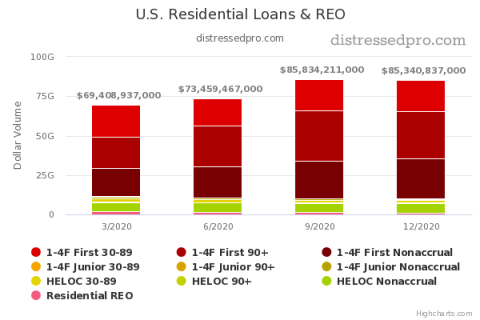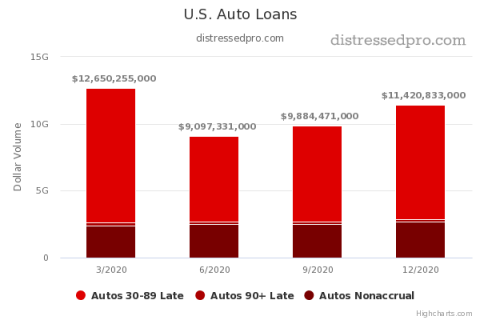The real data is in, and banks are reporting more first-time defaults and giving up on collecting on almost $2B more in residential mortgage loans.
The mainstream media seems only to be reporting how strong the market is, with new sales volume and price records being set. So, just how big is this crisis and opportunity that is hiding in the shadows?
Let’s find out….
Residential Non-Accrual Loans Surpass $25.6B
According to the Q4 data that US banking institutions reported, distress was only growing and moving further through the pipeline as we rolled into 2021.

Between October and December, the total dollar value of 1-4 unit residential non-performing loans and REO stayed around the level as Q3, at just under $86B. That’s up from just $69B in Q1 2020 when the first wave of COVID lockdowns was hammering the US.
What’s more noticeable is the number of first-time defaults rising slightly. The number of loans lenders have shifted to nonaccrual status, awaiting the green light to foreclose if not sold as paper to other investors.
Residential REOs
REOs continue to be a very small part of overall distress. At least for now. This seems to be a combination of forbearance agreements, foreclosure moratoriums, and banks purposefully holding off on foreclosures, as well as the lag time between new defaults and getting to this stage of distress.
In fact, there was just around $1.1B in REO value as of the end of the fourth quarter being reported by banks, compared to $2.2B at the beginning of 2020. That suggests they’ve done very well at liquidating and disposing of these non-performing assets that they have been able to foreclose on.
Non-Performing Residential Loans
The majority of distress is now in the 90-day-plus late stage of default among first-lien mortgage notes, a point from which few borrowers may be able to get back on track.
As of Q4, this category of non-performing first liens is made up of:
- $19.9B in 30-89 day late loans
- $29.6B in 90 day plus late and still accruing loans
- $25.5B in non-accrual loans
Use BankProspector to find banks with REOs and lenders holding nonaccrual loans.
Junior Liens
Revolving HELOCs in the nonaccrual stage are the next largest area of distress in the residential space, far surpassing any defaults in non-revolving second mortgage loans.
There were just $840M in nonaccrual-stage second mortgages as of the beginning of January 2021 versus $6.2B in nonaccrual revolving lines of credit. There are an additional almost $2B in other late revolving lines of credit behind those.
Consumer Debt: Auto Loans & Credit Cards
Auto loans have trended in the opposite direction of some other debt. Since mid-2020, defaulting auto loans have risen by around $1B per quarter, with $100M moving into the nonaccrual stage each quarter. New 30-89 day late auto loans stand at over $8.5B, with almost $2.7B in the nonaccrual stage.
This may suggest that many consumers are running out of savings and are finally falling behind, though there may also be many workouts by lenders. April’s tax refund season could change this as many workers look to buy new vehicles.

The end-of-year holiday season brought more credit card defaults, with around $1B in newly late lines of credit and $1B more 90 day plus late credit cards. Whether consumers can keep up with this debt may largely depend on a new round of individual stimulus checks being sent out in Q1 2021, as well as the expiration of eviction and foreclosure bans, which have enabled many to enjoy more disposable cash each month instead of paying for their housing.
Agricultural
Of special note is a substantial decline in distress in farmland and agricultural loans and REO, with around $800M fewer loans in default than in Q1 2020. This could be due to builders and others moving farther out from cities.
Big tech CEOs like Bill Gates have also been buying up tens of millions of dollars in vacant land over the past few years, while the new boom in cannabis startups is sprouting giant grow operations around the country.
Looking Ahead
Overall distress in the mortgage debt market appears to be growing moderately. While REOs continue to be hampered by foreclosure moratoriums, there is a significant build-up in residential first lien and HELOC, nonaccrual stage loans, as well as late CRE loans.
A lot is hanging by the thread of additional stimulus checks though the residential housing market seems to be on fire for prices and sales volume.
Those who recognize this distress and can make the contacts needed to get their hands on it are looking at the perfect conditions to make money in the middle of this. As Warren Buffett says, “when it rains gold, put out the bucket, not the thimble.â€
Log in to BankProspector now to see which banks are holding the most distressed loan notes.

